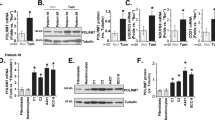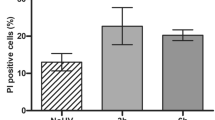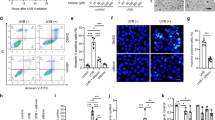Abstract
NAD(P)H:quinone oxidoreductase 1 (NQO1) is a cytosolic enzyme that protects cells against chemical and radiation-induced oxidative stress and skin cancer. Disruption of NQO1 gene in mice showed thinning of skin epithelium and loss of cytokeratin 14, an early marker of skin differentiation. Immunohistochemistry and western analysis demonstrated downregulation of p63 in NQO1−/− mouse skin, as compared with wild-type (WT) mouse. Further analysis including modulation of NQO1 expression revealed a direct correlation between the levels of NQO1 and p63 in skin-derived keratinocytes and dermal fibroblasts. Modulation of proteasomal activity revealed that p63 is degraded by 20S proteasome and that this degradation is significantly rescued by NQO1. Coimmunoprecipitation studies showed that NQO1 interacts directly with p63 but not 20S to protect against this degradation. In addition, benzo[a]pyrene treatment led to induction of NQO1 and stabilization of p63 in WT but not in NQO1−/− mouse skin and keratinocytes. These data suggest that NQO1 controls stabilization of p63 and progression towards keratinocyte differentiation leading to normal skin development and presumably skin carcinogenesis.
This is a preview of subscription content, access via your institution
Access options
Subscribe to this journal
Receive 50 print issues and online access
$259.00 per year
only $5.18 per issue
Buy this article
- Purchase on Springer Link
- Instant access to full article PDF
Prices may be subject to local taxes which are calculated during checkout






Similar content being viewed by others
References
Ahn KS, Sethi G, Jain AK, Jaiswal AK, Aggarwal BB . (2006). Genetic deletion of NAD(P)H:quinone oxidoreductase 1 abrogates activation of nuclear factor-kappaB, IkappaBalpha kinase, c-Jun N-terminal kinase, Akt, p38, and p44/42 mitogen-activated protein kinases and potentiates apoptosis. J Biol Chem 281: 19798–19808.
Arrowsmith CH . (1999). Structure and function of the p53 family. Cell Death Differ 12: 1169–1173.
Asher G, Dym O, Tsvetkov P, Adler J, Shaul Y . (2006). The crystal structure of NAD(P)H quinone oxidoreductase 1 in complex with its potent inhibitor dicoumarol. Biochemistry 45: 6372–6378.
Asher G, Tsvetkov P, Kahana C, Shaul Y . (2005). A mechanism of ubiquitin-independent proteasomal degradation of the tumor suppressors p53 and p73. Genes Dev 19: 316–321.
Candi E, Cipollone R, Rivetti di Val Cervo P, Gonfloni S, Melino G, Knight R . (2008). p63 in epithelial development. Cell Mol Life Sci 65: 3126–3133.
Chen S, Wu K, Knox R . (2000). Structure-function studies of DT-diaphorase (NQO1) and NRH:quinone oxidoreductase (NQO2). Free Rad Biol Med 29: 276–284.
Das A, Kole L, Wang L, Barrios R, Moorthy B, Jaiswal AK . (2006). BALT development and augmentation of hyperoxic lung injury in mice deficient in NQO1 and NQO2. Free Radic Biol Med 40: 1843–1856.
Fuchs E . (1996). The cytoskeleton and disease: genetic disorders of intermediate filaments. Annu Rev Genet 30: 197–231.
Gelboin HV . (1980). Benzo[a]pyrene metabolism, activation and carcinogenesis: role and regulation of mixed-function oxidases and related enzymes. Physiol Rev 60: 1107–1166.
Gong X, Kole L, Iskander K, Jaiswal AK . (2007). NRH:quinone oxidoreductase 2 and NAD(P)H:quinone oxidoreductase 1protect tumor suppressor p53 against 20S proteasomal degradation leading to stabilization and activation of p53. Cancer Res 67: 5380–5388.
Guengerich FP . (1988). Roles of cytochromes P-450 enzymes in chemical carcinogenesis and cancer chemotherapy. Cancer Res 48: 2946–2954.
Iskander K, Paquet M, Brayton C, Jaiswal AK . (2004). Deficiency of NRH:quinine oxidoreductase 2 increases susceptibility to 7,12-dimethylbenz(a)anthracene and benzo(a)pyrene-induced skin carcinogenesis. Cancer Res 64: 5925–5928.
Jaiswal AK . (2004). Nrf2 Signaling in coordinated activation of antioxidant gene expression. Free Rad Biol Med 36: 1199–1207.
Joseph P, Jaiswal AK . (1994). NAD(P)H:quinone oxidoreductase 1 (DT diaphorase) specifically prevents the formation of benzo[a]pyrene quinone-DNA adducts generated by cytochrome P4501A1 and P450 reductase. Proc Natl Acad Sci USA 91: 8413–8417.
Joseph P, Jaiswal AK . (1998). NAD(P)H:quinone oxidoreductase1 (NQO1) reduces the mutagenicity of DNA caused by NAD(P)H:P450 reductase activated metabolites of benzo[a]pyrene quinones. Br J Cancer 77: 709–719.
Joseph P, Klein-Szanto AJP, Jaiswal AK . (1998). Hydroquinones cause specific frame shift mutations involving deletion of a single cytosine from the DNA sequence 5′-CCCCC-3′ and lead to cellular transformation and in vivo tumorigenesis. Br J Cancer 78: 312–320.
King KE, Weinberg WC . (2007). P63: defining roles in morphogenesis, homeostasis, and neoplasia of the epidermis. Mol Carcinog 46: 716–724.
Koster MI, Dai D, Marinari B, Sano Y, Costanzo A, Karin M et al. (2007a). p63 induces key target genes required for epidermal morphogenesis. Proc Natl Acad Sci USA 104: 3255–3260.
Koster MI, Dai D, Roop DR . (2007b). Conflicting roles for p63 in skin development and carcinogenesis. Cell Cycle 6: 269–273.
Long II DJ, Iskander K, Gaikwad A, Arin M, Roop DR, Knox R et al. (2002). Disruption of dihydronicotinamide riboside:quinone oxidoreductase 2 (NQO2) leads to myeloid hyperplasia of bone marrow and decreased sensitivity to menadione toxicity. J Biol Chem 277: 46131–46139.
Long II DJ, Waikel RL, Wang XJ, Perlaky L, Roop DR, Jaiswal AK . (2000). NAD(P)H:quinine oxidoreductase 1 deficiency increases susceptibility to benzo(a)pyrene induced mouse skin carcinogenesis. Cancer Res 60: 5913–5915.
Long II DJ, Waikel RL, Wang XJ, Roop DR, Jaiswal AK . (2001). NAD(P)H:quinine oxidoreductase1 deficiency and increased susceptibility to 7,12-dimethylbenz[a]-anthracene-induced carcinogenesis in mouse skin. J Natl Cancer Inst 93: 1166–1170.
Melino G, Gallagher E, Aqeilan RI, Knight R, Peschiaroli A, Rossi M et al. (2008). Itch: a HECT-type E3 ligase regulating immunity, skin, and cancer. Cell Death Differ 15: 1103–1112.
Mills AA, Zheng B, Wang XJ, Vogel H, Roop DR, Bradley A . (1999). p63 is a p53 homologue required for limb and epidermal morphogenesis. Nature 398: 708–713.
Moll UM, Slade N . (2004). p63 and p73: Roles in development and tumor formation. Mol Cancer Res 2: 371–386.
Pietsch EC, Sykes SM, McMahon SB, Murphy SE . (2008). The p53 family and programmed cell death. Oncogene 27: 6507–6521.
Radjendirane V, Joseph P, Jaiswal AK . (1997). Gene expression of DT-diaphorase (NQO1) in cancer cells. In: Forman HJ, Cadenas E (eds). Oxidative Stress and Signal Transduction. Chapman & Hall: New York. pp 441–475.
Radjendirane V, Joseph P, Lee YH, Kimura S, Klein-Szanto AJ, Gonzalez FJ et al. (1998). Disruption of the DT diaphorase (NQO1) gene in mice leads to increased menadione toxicity. J Biol Chem 273: 7382–7389.
Romano RA, Ortt K, Birkaya B, Smalley K, Sinha S . (2009). An active role of the DeltaN isoform of p63 in regulating basal keratin genes K5 and K14 and directing epidermal cell fate. PLoS One 4: e5623.
Ross D, Kepa JK, Winski SL, Beall HD, Anwar A, Siegel D . (2000). NAD(P)H:quinone oxidoreductase1 (NQO1): chemoprotection, bioactivation, gene regulation and genetic polymorphism. Chem Biol Interact 129: 77–97.
Salvat C, Acquaviva C, Scheffner M, Robbins I, Piechaczyk M, Jariel-Encontre I et al. (2000). Molecular characterization of the thermosensitive E1 ubiquitin-activating enzyme cell mutant A31N-ts20. Eur J Biochem 267: 3712–3722.
Shen J, Barrios RJ, Jaiswal AK . (2010). Inactivation of the quinine oxidoreductases NQO1 and NQO2 strongly elevates the incidence and multiplicity of chemically induced skin tumors. Cancer Res 70: 1006–1014.
Talalay P, Fahey JW, Holtzclaw WD, Prestera T, Zhang Y . (1995). Chemoprotection against cancer by phase 2 enzyme induction. Toxicol Lett 82–83: 173–179.
Yang A, Schweitzer R, Sun D, Kaghad M, Walker N, Bronson RT et al. (1999). p63 is essential for regenerative proliferation in limb, craniofacial and epithelial development. Nature 398: 714–718.
Acknowledgements
We thank our colleagues for helpful discussions and suggestions. This work was supported by NIH Grant RO1 ES007943. BAP was supported by Grant RO1 ES007943 and also in part is supported by NIEHS training Grant ES007263.
Author information
Authors and Affiliations
Corresponding author
Ethics declarations
Competing interests
The authors declare no conflict of interest.
Rights and permissions
About this article
Cite this article
Patrick, B., Gong, X. & Jaiswal, A. Disruption of NAD(P)H:quinone oxidoreductase 1 gene in mice leads to 20S proteasomal degradation of p63 resulting in thinning of epithelium and chemical-induced skin cancer. Oncogene 30, 1098–1107 (2011). https://doi.org/10.1038/onc.2010.491
Received:
Revised:
Accepted:
Published:
Issue Date:
DOI: https://doi.org/10.1038/onc.2010.491
Keywords
This article is cited by
-
NQO1-induced activation of AMPK contributes to cancer cell death by oxygen-glucose deprivation
Scientific Reports (2015)
-
Stress-induced NQO1 controls stability of C/EBPα against 20S proteasomal degradation to regulate p63 expression with implications in protection against chemical-induced skin cancer
Oncogene (2012)
-
miR-205 regulates basement membrane deposition in human prostate: implications for cancer development
Cell Death & Differentiation (2012)



